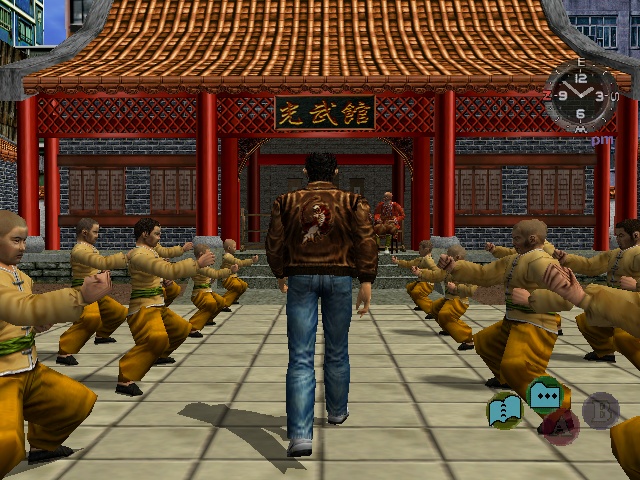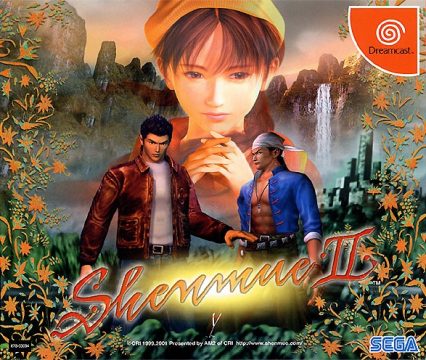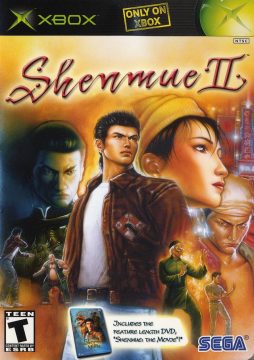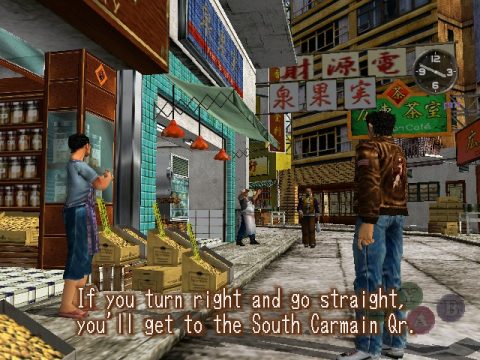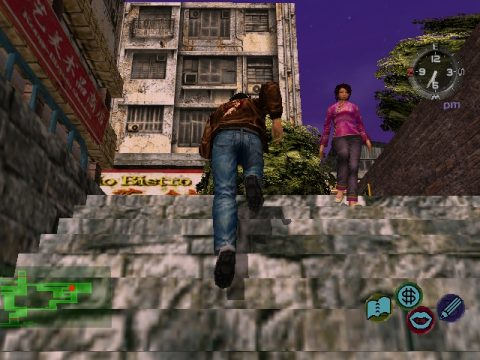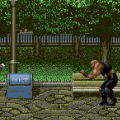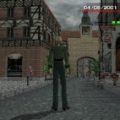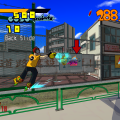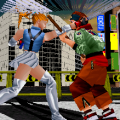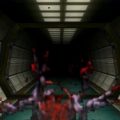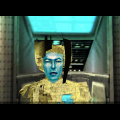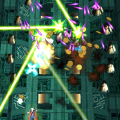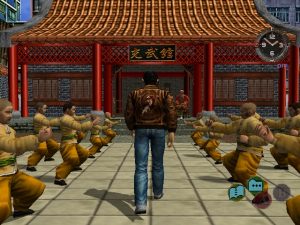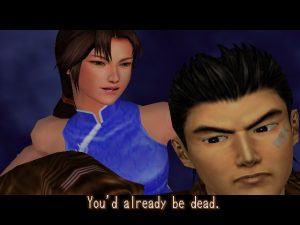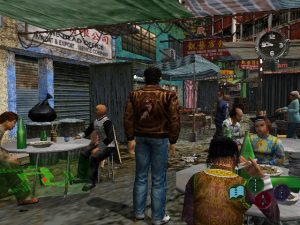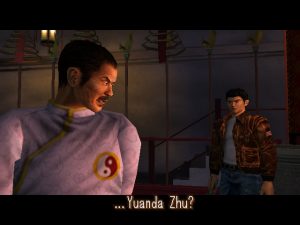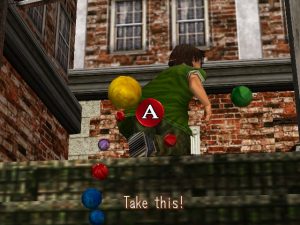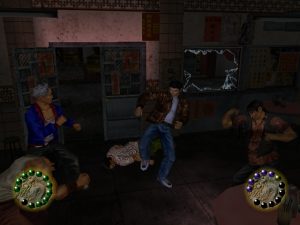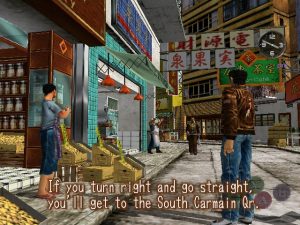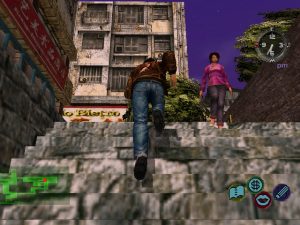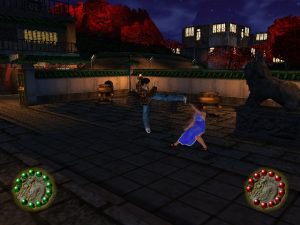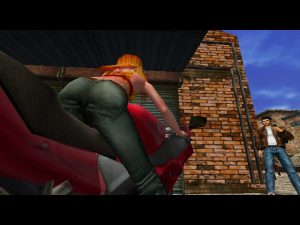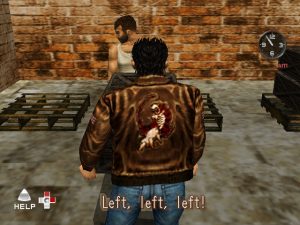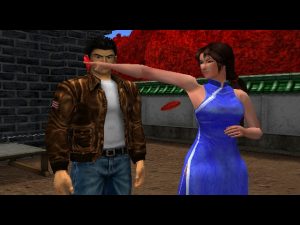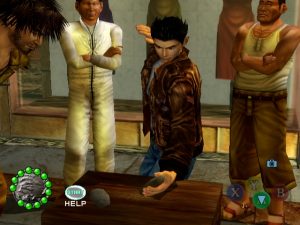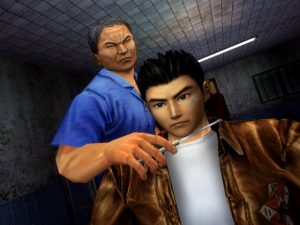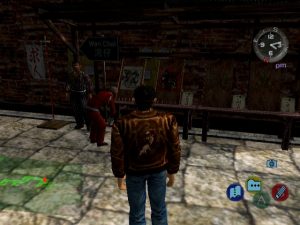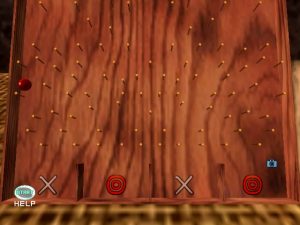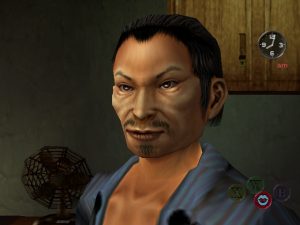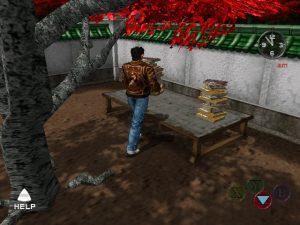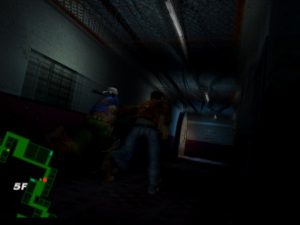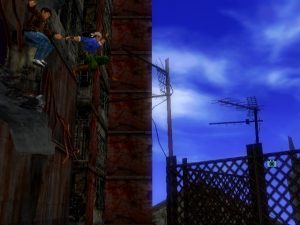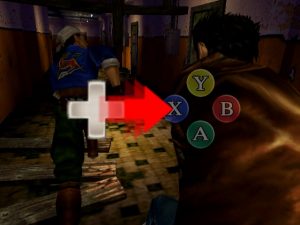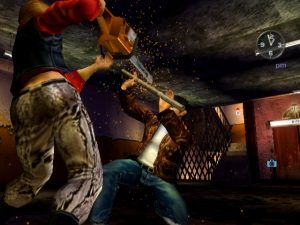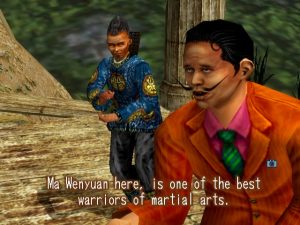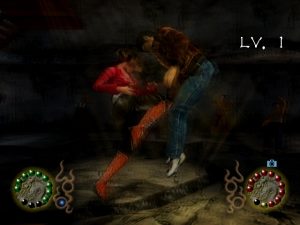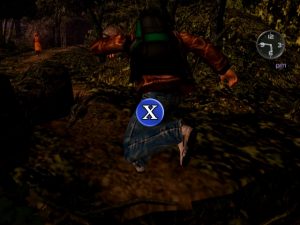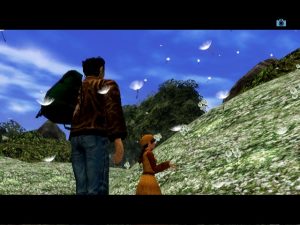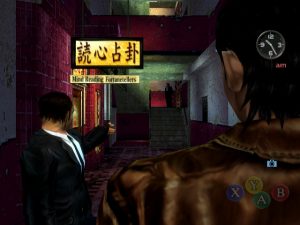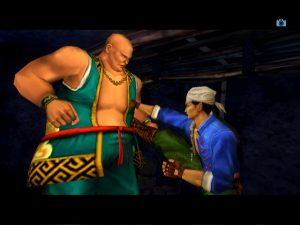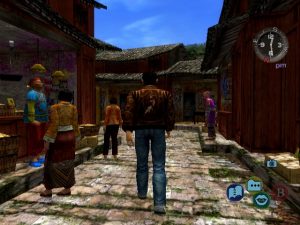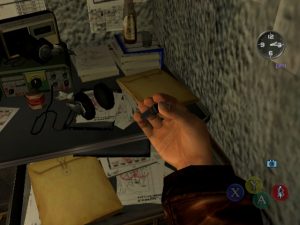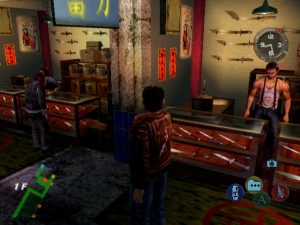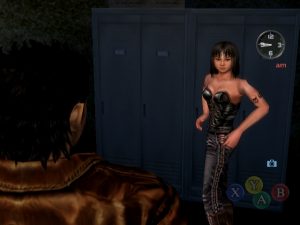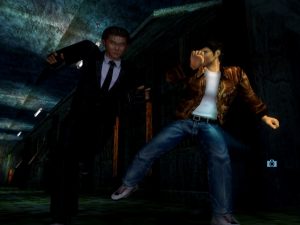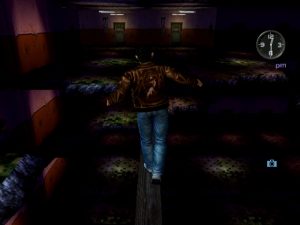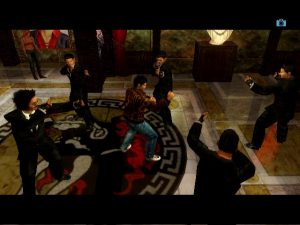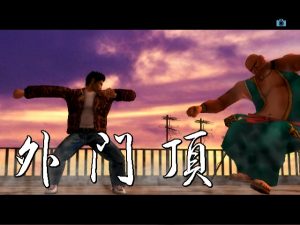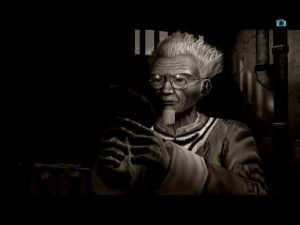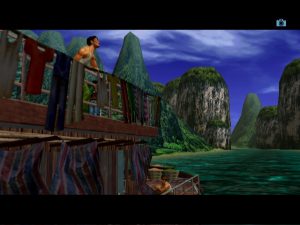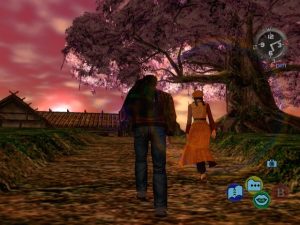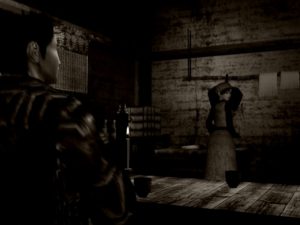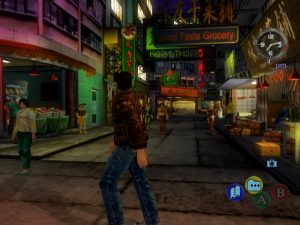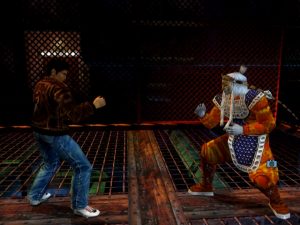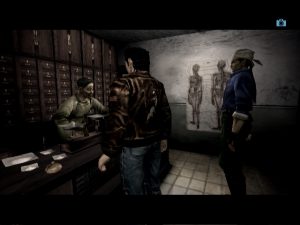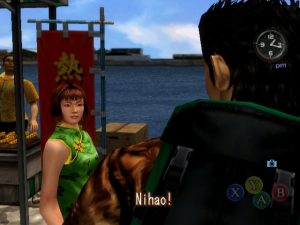- Shenmue
- Shenmue II
- Shenmue (Misc)
Shenmue II doesn’t waste a second recapping the events of the original – within the first few minutes, Ryo steps off the boat and onto the foreign land of Hong Kong, searching for a martial arts master named Lishao Tao, as guided by Master Chen.
On the surface, it seems as if only the setting has changed, but there are some minor improvements to the gameplay. If Ryo arrives for an event too early, he can choose to pass time automatically, so you don’t need to sit around doing nothing. You can also buy maps for most of the areas, which are shown onscreen in the corner and drastically help navigation. When asking for directions, many people will also guide you there personally, making it much easier to find different locations, but their slow walking speed really puts your patience to the test. At the beginning of each day, you’re also given the option to automatically jump to important areas, which cuts down on the random running around. The controls also feel less stiff than in the first game, although the scheme hasn’t changed at all, and Ryo still tends to get stuck in corners.
New Characters
Joy
A biker chick with brightly died hair and a skimpy outfit, Joy takes immediate interest in Ryo and begins helping him on his quest. It’s never explicitly spelled out why, but it seems she has a bit of a crush on him. Joy knows all of the guys at the harbor, and hooks Ryo up with a job if he needs one.
Wong
This little scamp runs with the local gang and helps steal Ryo’s bag at the beginning. Eventually he wises up and helps Ryo on his quest, putting his lockpicking skills to much use.
Hong Xiuying
The master of the Man Mo Temple in Hong Kong aids Ryo in his quest a little, though she doesn’t approve of his cause. Her brother went also after the Chi You Men seeking revenge. She believes he actually joined them.
Xun Fangmei
An orphan girl that was picked up by Xiuying. Although she only interacts briefly with Ryo on a few occasions during his stay at Xiuying’s place, she’s the first to inform him about Xiuying’s and Ziming’s past.
Ren Wuying
Your classic Han Solo-ish antihero who cares only about money, money and, um, money. He’s the leader of a gang called The Heavens and becomes an accomplice to Ryo in the second game. While he always keeps up his act as a greedy bastard, he isn’t really a bad person.
Hong Kong is a very different place than Yokosuka. The city is an odd mixture of Western and Asian architecture, since it’s a British colony populated by Chinese people. You’ll run past European style brick buildings before coming across an Asian style bridge. It goes to great lengths to drive in the point that you’re in foreign territory, although it just glosses over the established fact of the first Shenmue that Ryo doesn’t speak one bit of Chinese. (In the early stages of design, Shenmue II was supposed to be dubbed entirely in Cantonese, the Chinese dialect spoken in Hong Kong, but this was probably a little bit too ambitious.) While there are plenty of friendly people, Ryo gets his bag stolen right as he gets off the boat, then he’s attacked by gang members. Hong Kong is also far more economically diverse than the middle class Yokosuka, and there are quarters filled with dingy street markets and decrepit apartments.
Since you’ve been robbed of your cash, you need to take up random jobs – there’s no forklifting this time, but Ryo can move crates at the harbor for money, gamble, arm wrestle, or run Lucky Hit stands, all while trying to locate Lishao Tao. After days of searching, Ryo eventually meets up with Xuiying (Lishao Tao’s real name), and takes a job at the Man Mo Temple. Once again, you spend most of this segment wandering around, getting clues, and eventually learning than Lan Di is on the Kowloon Peninsula, somewhere inside the Walled City.
When Ryo first steps into Kowloon, suddenly the pace hits high gear, especially when he meets up with Ren. Ren is an interesting match for Ryo – he’s just as brash and tough, but much more street smart and quite a bit louder. His presence also makes the story far more interesting, not only because it actually gives Ryo a foil, but gives the plot more direction. There’s significantly less of the random stumbling around.
But you can still do that if you want – Kowloon is absolutely huge. The Walled City used to be one of the most densely populated areas of the planet, and also happened to be hugely infested with crime, considering it wasn’t technically ruled by any country. It’s also a city seemingly on the edge of permanent decay. Almost everyone seems to live in total squalor. All of the music is dark and depressing. Many of the buildings are filthy, dimly lit and completely falling apart. Most of these structures are interconnected and at least a dozen stories high, and almost all of them can be explored thoroughly. At one point, you need to scale a building that has had a huge chunk torn out from the middle of it, and need to balance across wood planks to make it to the top. The only issue with the expansive environments is that they’re significantly less detailed than earlier parts of the game. Apartment buildings consist of the same few doors and textures repeated over and over, but that’s the price to be paid for a game of this scale.
But it’s not only the atmosphere that makes Kowloon intriguing, because there’s also significantly more action. There are a lot more QTEs this time around, such as when Ryo needs to sneak into mafia headquarters and stealthily dispose of guards. Some of these require a lot of attention, because if you fail, you won’t immediately get a second chance like in the first game. Compared to the original, there are also tons of one-on-one fighting sequences, as Ryo travels around, participating in various tournaments to gain gang respect. They’re substantially more difficult than anything in the previous game, and definitely require that you spend time learning some of your special moves if you want to win. This whole chapter is extraordinarily fascinating, and is easily the highlight of the Shenmue series.
The Kowloon segment ends with Lan Di getting away, but Ryo leaves for the secluded Chinese province of Guilin. There’s really very little to do in these segments but walk forward, admire the scenery, and chat with Shen Hua. It somehow manages to be both gorgeously minimalist and kinda boring – because while they obviously put a lot of work into both Shen Hua and her homeland, there’s not much actual game playing going on. When the two finally reach a cave out in the middle of nowhere, the two mirrors activate and… that’s it. The game ends on a cliffhanger that was never resolved.
Shenmue II was originally released in 2001 for the Dreamcast in Japan. It was to be released in English shortly thereafter – however, Microsoft signed an exclusivity deal for the game to be released in America only for the Xbox. Not only did this result in the cancellation of the American Dreamcast version, but the release was delayed a whole year while the game was ported. Luckily, the Dreamcast version was still released in Europe, a mere two months after the Japanese version. In order to speed up the localization process an minimize costs, all of the dialogue is left in Japanese, and the entire game is subtitled. The game has a 60 Hz mode and is completely playable on NTSC Dreamcasts with a boot disc, so many American fans simply chose to import this rather than wait for the Xbox version. Unfortunately, due to regional differences, cleared save files from the American Shenmue were incompatible with the European Shenmue II, so none of the extra items could be transferred. In this case, Ryo simply starts out with a ton of toys from the original game, most of which can be sold for cash and makes the early stages of the game much less tedious.
When the Xbox version came out a year later, not much was added. Most of the graphics are the same, although they’ve been slightly filtered to reduce the texture shimmering, shadows have been improved, and there’s some additional bloom lighting effects in certain areas. It goes more than a bit overboard with the motion blur during battles, though. During exploration there’s less slowdown, and more characters can be seen on the screen at a time, although they still fade in and out occasionally. You can change visual filters to alter the colorization (to make it look more like a movie) or take snapshots of your favorite moments. However, other than the additions of some mini-comics that can be unlocked by taking pictures of certain characters, there’s nothing really new. The Xbox version puts you in a better position than starting Shenmue II on Dreamcast without an imported save, as it gives Ryo all the optional martial arts moves that can be learned throughout the first game.
Both versions include a Shenmue Digest movie, which plays in a tiny window and plays various cutscenes from the original game. The Xbox version includes a separate DVD that contains Shenmue: The Movie. A prerelease video of the unreleased Sega Saturn game can be unlocked on both platforms by beating the game. All the mini games and arena fights can be accessed directly, too, once they’ve been played in the main game.
There is one minor change between the Japanese and English releases. In the Japanese version, Dou Niu’s partner/lover, Yuan, is meant to be a rather effeminate man. In the English version, they changed the “him” into a “her”, giving her a clearly feminine voice.
Key Events
After you get robbed in the beginning, you eventually retrieve your bag, but you can’t get your cash back. So you need to find a way to earn some money. The best way is simply to sell some crap at the pawn shop, but you can also get a job at the Lucky Hit stands peppered liberally throughout Hong Kong. Lucky Hit is very similar to the stupidly popular (in Japan) pachinko, where you drop a ball down a pegged board and hope it lands in a winning slot. You can choose to run one of these stands and bark out at passerbys (imagine hearing “Would you like to try a game of Lucky Hit?” over and over), hoping you can win and steal their money. It’s a stupid activity and you should avoid it if you actually want to enjoy Shenmue II.
One of the major activities in Hong Kong is learning the Four Wude, which are basically important life lessons. You learn these by tracking down different martial artists around the city. One of the coolest is a barber, who offers to give you a trim before he lets you in on the secret. He begins sharpening his tools in the background, makes some menacing remarks, and commands you not to move, no matter what happens. Then he pulls the knife to your throat and a QTE event pops up. If you hit the button – and if you’ve been playing a lot of Shenmue, you probably will just out of reflex – you jump out of the chair, and lose, requiring that you come back a whole day later to try again. Keep still, and you’ll earn the barber’s respect, learning one of the crucial Wude. (Which is, in this case, the ability to remain calm under pressure.)
When you first arrive in Hong Kong, you find lodgings at the Come Over Guest House. Even though it technically costs money to stay, you can opt just to put the bill on your tab, and then never ever pay it, without any repercussions whatsoever. When you eventually meet up with Xiuyang, she lets you crash at her apartment, but only if you spend each morning carrying books from temple and airing them out. It’s not quite as stupidly annoying as the forklift stuff – and it’s not as slow-paced as the box moving game, which is the first job Joy gets you – but it’s still awfully unexciting.
At one point, Ryo ends up running into Dou Niu, the massive crime lord. Ren tries to come in and save the day, but both of them are pummeled, chained up, and left to rot in a jail cell. Eventually they hatch a cunning escape plan, but they’re still bound together with handcuffs, and need to make every action in unison in order to escape. It’s pretty cool how like every apartment building in Kowloon is rotting and has huge holes in the floor. There’s also a semi-hilarious Warner Bros. cartoon style moment when Ryo and Ren find a door labeled “Exit”, only to discover that the only thing lying on the other side is thin air, requiring that the two make a fantastic leap of faith.
To gain the respect of the Yellow Head Gang, Ryo has to participate in all kinds of martial arts challenges around Kowloon. These 1-on-1 contests are the most challenging fight scenes in the entire game, and most have some unique conditions. There’s a one-eyed fighter who can only be attacked from his bad side, a super-swift old man Ryo has to hit at least once within the time limit, and a trio of mongolian ringers, who have to be defeated all in a row.
The other awesome QTE chase scene is when Ryo and Ren are chased by Yuan, who happens to be wielding a chainsaw. One wrong move, and you actually get killed. You still restart the segment over as if nothing happened, and there’s no blood (it just fades quickly to white – it’s definitely no Resident Evil 4), but it’s one of the few times in Shenmue where Ryo’s life is actually in danger. It’s pretty intense.
The whole final chapter of Shenmue II has Ryo and Shenhua walking through mountain passes in Guilin province. While not much actually happens the whole time, you’ll encounter some of the most beautiful depictions of nature in a video game. Here the game also first hints at the coming supernatural elements, when Shenhua blows a whole field of dandelion seeds with the power of her mind.
Comparison Screenshots
